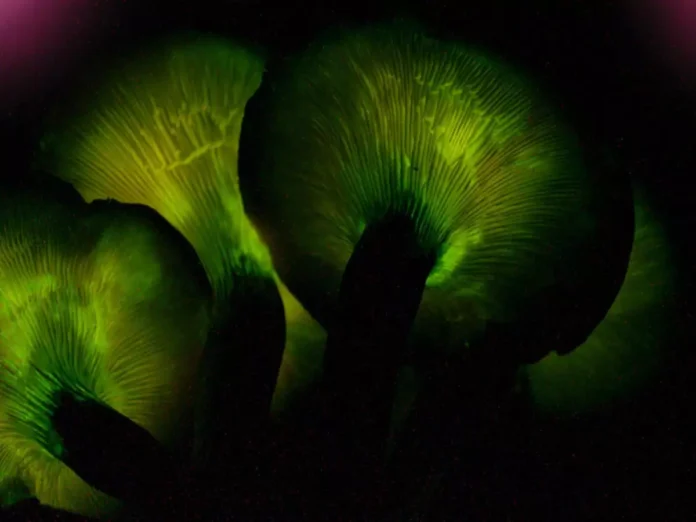In the forests of Kasaragod, researchers have discovered a rare species of bioluminescent mushrooms that emit a brilliant, otherworldly green light in the darkness of night. According to a report by ONmanorama, these fascinating fungi, scientifically known as Filoboletus manipularis, were found after a micro-fungal survey conducted jointly by the Kasaragod division of the Kerala Forest and Wildlife Department and the Mushrooms of India Community in the Ranipuram forest.
Dilip Kumar Rai, a botany expert and principal at Yangsum Senior Secondary School in Sikkim, praised the discovery. “The discovery of Filoboletus manipularis in Kasaragod is a remarkable addition to our understanding of fungal biodiversity,” he explained. These mushrooms, capable of producing their own light through a biochemical process, add to the rich biodiversity of the region and offer new avenues for scientific exploration.
Researchers conducting the survey were thrilled to find these bioluminescent mushrooms, which stand out due to their unique ability to glow in the dark. This glow is the result of a chemical reaction involving luciferin, a compound found in the mushrooms, and oxygen. The resulting luminescence is not only a stunning visual phenomenon but also serves various ecological functions, such as attracting insects that aid in spore dispersal.
Despite their enchanting appearance, scientists have issued a warning against the consumption of these mushrooms. The Kerala Forest and Wildlife Department emphasized that while Filoboletus manipularis is a rare and beautiful species, its edibility remains unknown. Consuming wild mushrooms without proper identification and knowledge can lead to serious health risks, including poisoning.
Researchers continue to study these mushrooms to better understand their ecological role and potential uses. Their ability to produce light could have applications in scientific research and biotechnology, but for now, the primary focus is on conservation and understanding their natural habitat.
The discovery has sparked significant interest among mycologists and nature enthusiasts, highlighting the need for continued exploration and conservation of fungal species in India’s forests. The Kasaragod division of the Kerala Forest and Wildlife Department and the Mushrooms of India Community plan to conduct further surveys to explore the extent of this species’ presence and ensure its protection.
This remarkable discovery has also brought attention to the delicate ecosystems within the forests of Kasaragod. Conservationists stress the importance of protecting these habitats, which harbor numerous undiscovered and rare species. The bioluminescent mushrooms, with their unique glow, serve as a reminder of the many hidden wonders that exist within these forests.
Local communities have shown a keen interest in the mushrooms, with many eager to witness the bioluminescence firsthand. Guided tours and educational programs are being considered to allow people to view these natural marvels while learning about the importance of conservation and responsible foraging practices. These initiatives aim to foster a greater appreciation for the region’s biodiversity and promote sustainable tourism.
Dr. Anjali Menon, a mycologist involved in the survey, highlighted the potential for these mushrooms to contribute to scientific advancements. “The biochemical processes that enable these mushrooms to produce light can inspire innovative applications in fields such as medicine, environmental monitoring, and bioengineering,” she said. Researchers are particularly interested in studying the enzymes involved in the bioluminescence, which could have broader implications for biotechnological research.
The Kerala Forest and Wildlife Department, in collaboration with local academic institutions, plans to launch detailed ecological studies to understand the environmental factors that support the growth of Filoboletus manipularis. These studies will help in developing strategies to preserve the species and its habitat, ensuring that the mushrooms continue to thrive in their natural environment.
As word of the discovery spreads, there is also a growing call for responsible exploration of natural sites. Environmentalists urge visitors and amateur mycologists to follow guidelines that protect the habitat and avoid disturbing the delicate ecosystem. They emphasize the importance of leaving no trace and respecting the natural environment to ensure that future generations can also experience these wonders.

